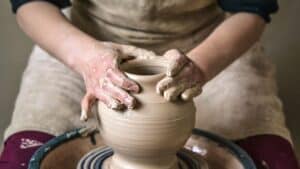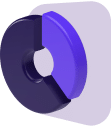Art comes in many forms, and pyrography is one of the most inexpensive and fun ways to express yourself. The art uses a pyrography pen to burn your ideas to a clean piece of wood.
As any source of heat works as a pen, the most important tools of the trade are your skills and the wood you use.
So, what is the best wood for pyrography? While you can use any wood for pyrography, the most popular choices are woods like Basswood, Birch, Poplar, and even Pine board. Lighter colored woods with subdued grain patterns tend to showcase the detail and contrast of your design much better.
You also want to select the right grain of the wood that best suits your style of art. Together with proper training, the perfect grain of pinewood would bring out your ideas.
To be sure you get off to a great start, take the time to read through my other articles on pyrography basics and equipment. Click here to access them all.
The Tools Required to Start Pyrography
Similar to sculpting, in pyrography, you burn your ideas onto the surface of the wood.
You can use the technique to personalize your woodworking products with your name or carve a scene or design. Your pyrographic options are only limited by your imagination.
Pyrography uses heat to transform wood and other materials into works of art.
It is one of the easiest and more inexpensive do-it-yourself (DIY) projects available today.
All you need is a piece of wood, a heated object, and your imagination to present your creativity to the world.
Check out my Complete Beginners Guide to Pyrography here.
Wood Burning Pen and Tips
Most pyrography artists prefer to use a dedicated wood burning pen, like this one. These pens are solid-point burners that look like soldering irons.
Wondering if soldering irons are ideal for pyrography or if they can be used at all? I cover that topic in this article.
With wood burning pens, an electrical element heats their solid brass tips to keep them at a fixed operating temperature. High-end pens let you control the heat through a wire-nib burner.
By the way, if you’d like to try your hand at pyrography on leather, the above wood burning pen or the one in the kit below will work on wood and leather.
Beginner’s Wood Burning Kit
The Wood
The pen is nothing if you do not have the wood to burn. Fortunately, you can use any type of wood, though some woods are better than others.
For instance, you can just use free pallet wood, provided they are chemical-free. You just have to sand them down to create your canvas.
You can also use precut wood squares. I found this 36-piece pack on Amazon to be perfect for small projects and designs like coasters and ornaments.
Some of the more popular wood include:
- Basswood
- Birch plywood
- Poplar
- Pallet wood (be sure it’s not been chemically treated)
- Pine (processed pine board)
Carbon Paper
While not required, you can use carbon paper to provide better accuracy to your burns. This pack comes with 200 pieces of carbon paper and tracing styluses — such a great deal, too.
You just place the paper on your board and under your design and then trace over the design with a pencil. You can then just burn the wood over the pencil lines.
Personally, I like to use premade stencils on occasion. In this article here, you’ll find which ones I recommend and pointers for using them correctly and safely.
Wood Used in Pyrography
Artists have burned every type of wood to create their artwork. Though, you get better results if you use the right wood for your project.
All that matters in pyrography is that the wood you use has the color you need with minimal grain.
You may also want something soft enough to burn with lower temperatures to reduce the risks and energy use.
Regardless of the wood you use, you want wood that at least 3/8 inches thick.
Thinner woods curl and bow as they age. The exception is plywood, making it an excellent wood for projects which require thin canvases. Plywood is just more susceptible to water damage.
However, you never want to use finished or reclaimed wood, nor do you want plastic or another synthetic material.
Wood burning releases fumes from the heating.
Therefore, you want something which does not contain hazardous contaminants. Your art is not worth risking your health.
Is pyrography truly safe? Do you need any special safety gear? You’ll find the answers here.
To get you started, here are some popular pyrography wood types and their advantages and disadvantages.
Alder
Alder is a dark hardwood. It burns smoothly because it has no sap or resin. It is also very common and inexpensive.
Pros:
- Easy to burn despite the hardness
- Contains no sap or resin
- Inexpensive, can be found in most home improvement stores
Cons:
- Comes in only a limited number of widths, typically just 4 inches wide
- Dark color
- Very grainy
Balsa Wood
Balsa wood is too soft for most projects, but it is great is you want some light wood for woodworking projects.
You can burn a design for your model plane, of instance. However, you cannot use it for anything else.
Balsa wood only comes in solid carving blocks or thin model-making strips.
Pros:
- Minimal grain
- Very light color
- No sap or resin
- Extremely soft wood – great for embossed lines, divots, and grooves
Cons:
- Difficult to find except for very thin strips
- Tends to curl
- Pen tips can get stuck in the wood
- Easy to gouge
Basswood
Basswood is a great wood for decorative art. It is also inexpensive and easy to obtain.
Pros:
- Softwood with a minimal grain
- No sap or resin
- Very light to light color with a yellow tint
- Inexpensive and easy to find
Cons:
- Too soft for non-decorative projects
- Easy to gouge
Beech
Beech is a nice, light hardwood, but it contains sap and has a dark grain. It is much better for pyrography as plywood.
Pros:
- Inexpensive hardwood
- Light color
- Plywood form has no resin
Cons:
- Can have resin-filled dark dashes in the grain
- Hard to burn properly
- Tends to splinter
Cherry
Cheery is a very dark hardwood with pale streaks. Because it is not uniform in color, many artists ignore it.
You almost always find it with a finish as well. However, it has no resin, making it a nice wood if you want the multi-color effect.
Pros:
- No sap or resin
- Very dark hardwood
Cons;
- Can be too dark
- Not uniform in color
- Sometimes comes with a finish
Hickory
Hickory is great for decorative projects, but not much else.
While it is a good hardwood with no resin, it is often too dark to use in most projects, and it has a very pronounced grain. It also has an uneven color pallet.
Pros:
- No sap or resin
- Sturdy hardwood
Cons:
- Very dark color
- High grain and color variations
Maple
Maple is a great light-color hardwood, but it can be quite expensive. It has no resin or grain to get in your way either.
Pros:
- Light hardwood with minimal grain
- No sap or resin
- Gouge resistant
Cons:
- Expensive and difficult to find
- Very hard to burn with a pen
Oak
Oak has too much grain for pyrography. Your result will end up streaky and banded. It has no sap and is relatively hard, so people do use it, but you can find much better wood.
Pros:
- Hardwood
- No sap or resin
Cons:
- Dark color
- Expensive
- High grain with color variations
Pacific Albus
Pacific Albus is popular among artists who like the hybrid feel of the wood. Similar to balsa wood, Albus tends to be very light in color with minimal grain or resin.
It is also very soft. You can bend it into different shapes for grooves, embossing, and divots.
Pros:
- Very light color hardwood with no sap or resin
- Softwood with minimal grain
- Inexpensive
Cons:
- Thin and prone to curving
- Pen tips can sink into the wood
- Easy to gouge
Pine
While natural pine is very resinous, pine board is among the best wood for pyrography. The processed wood has some resin while keeping the wood’s light hardwood color.
Pros:
- Light tan color
- Inexpensive
- Soft hardwood
- Processed boards have no sap or resin
Cons:
- Natural boards have high resin content
Prepping the Wood for Optimal Burning
You cannot use any wood as they are sold in pyrography. You will always have to sand and prepare the wood before you burn it.
While sanding seems tedious, you can do it a four-step process.
- Sand the wood in sequence to at least 220 grit – Depending on the smoothness of the wood, you need to sand the surface down using successively rougher sandpaper starting with 60 grit paper. You want to keep sanding until the board is ready for the final sanding.
- Wet the sanded wood – Once your sand the wood to 220 grit, you must wet the wood using a wet sponge. Wipe over the entire surface of the wood. You want it to want it damp but not dripping.
- Dry the wood – place the wood somewhere to air dry for a few hours
- Res-and using 220 grit – Once the wood is dry, you want to sand the surface smooth. Once smooth to the touch, the wood is ready to use.
Ready to start your first project? Be sure to check out our Beginner’s Guide to Wood Burning.








